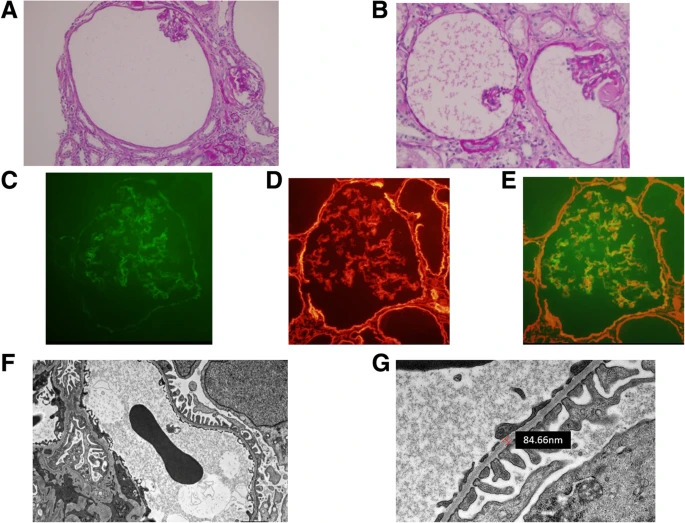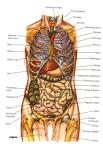Sandbox:Marufa Marium: Difference between revisions
No edit summary |
No edit summary |
||
| (11 intermediate revisions by the same user not shown) | |||
| Line 3: | Line 3: | ||
==Overview== | ==Overview== | ||
Von Willebrand’s Disease: | Von Willebrand’s Disease: | ||
[[Image:Thin_Basement_Membrane_Disease.jpg|thumb|1(A) and 1(B) showing light microscopy of Thin basement membrane disease with cystic dilation. 1(C), 1(D), 1(E) showing GBM using different Immunofluoroscence. 1(F), 1(G) showing thin GBM without electron deposition using Electron microscopy Courtesy: https://bmcnephrol.biomedcentral.com/articles/10.1186/s12882-019-1451-6/figures/2|500px|right|]] | |||
==Historical Perspective== | ==Historical Perspective== | ||
Von Willebrand’s Disease(vWD) was first discovered by Erik Adolf von Willebrand, a Finnish Physician, in 1926, in a Swedish-language article “Hereditär pseudohemofili” ("Hereditary pseudohemophilia") after assessing a 5 year-old Finnish Girl and 66 members of her family from 1924-1926. In 1957, decreased level of a plasma factor ‘ Factor ⅷ later called ‘Von Willebrand factor’ were first identified in the pathogenesis of Von Willebrand’s Disease. In early 1970s Ristocetin was used to diagnose vWD after inducing platelet aggregation <ref name="pmid24978322">{{cite journal |vauthors=Favaloro EJ |title=Diagnosing von Willebrand disease: a short history of laboratory milestones and innovations, plus current status, challenges, and solutions |journal=Semin. Thromb. Hemost. |volume=40 |issue=5 |pages=551–70 |date=July 2014 |pmid=24978322 |doi=10.1055/s-0034-1383546 |url=}}</ref> . Later immunoprecipitation techniques were used to understand vWD and it’s varieties. | [[File:Thin_Basement_Membrane_Disease.jpg|thumb|500px|right|1(A) and 1(B) showing light microscopy of Thin basement membrane disease with cystic dilation. 1(C), 1(D), 1(E) showing GBM using different Immunofluoroscence 1(F), 1(G) showing thin GBM without electron deposition using Electron microscopy Courtesy: https://bmcnephrol.biomedcentral.com/articles/10.1186/s12882-019-1451-6/figures/2|]] | ||
[[Image:Humanbody.jpg|thumb|This text is displayed.|70px|right]] | |||
[[Image:Humanbody.jpg|thumb|Anatomy|200px|right|Human Body]] | |||
Von Willebrand’s Disease(vWD) was first discovered by Erik Adolf von Willebrand, a Finnish Physician, in 1926, in a Swedish-language article “Hereditär pseudohemofili” ("Hereditary pseudohemophilia") after assessing a 5 year-old Finnish Girl and 66 members of her family from 1924-1926. In 1957, decreased level of a plasma factor ‘ Factor ⅷ later called ‘Von Willebrand factor’ were first identified in the pathogenesis of Von Willebrand’s Disease. In early 1970s Ristocetin was used to diagnose vWD after inducing platelet aggregation <ref name="pmid24978322">{{cite journal |vauthors=Favaloro EJ |title=Diagnosing von Willebrand disease: a short history of laboratory milestones and innovations, plus current status, challenges, and solutions |journal=Semin. Thromb. Hemost. |volume=40 |issue=5 |pages=551–70 |date=July 2014 |pmid=24978322 |doi=10.1055/s-0034-1383546 |url=}}</ref> . Later immunoprecipitation techniques were used to understand vWD and it’s varieties. [[File:Platelets.jpg|thumb|300px|left|]] | |||
[[Image:Humanbody.jpg|thumb|Anatomy|200px|right|Human Body]] | |||
==Classification== | ==Classification== | ||
[[vWD]] may be classified according to [[Hereditary]] and [[Aquired]] causes. | [[vWD]] may be classified according to [[Hereditary]] and [[Aquired]] causes. | ||
| Line 13: | Line 19: | ||
*Pseudo or platelet-type | *Pseudo or platelet-type | ||
[[Aquired]] vWD is thought to be caused by [[Autoantibodies]]. It can be subclassified into lymphoproliferative, cardiovascular, myeloproliferative, neoplastic, autoimmune disorders <ref name="pmid11838652">{{cite journal |vauthors=Kumar S, Pruthi RK, Nichols WL |title=Acquired von Willebrand disease |journal=Mayo Clin. Proc. |volume=77 |issue=2 |pages=181–7 |date=February 2002 |pmid=11838652 |doi=10.4065/77.2.181 |url=}}</ref> . | [[Aquired]] vWD is thought to be caused by [[Autoantibodies]]. It can be subclassified into lymphoproliferative, cardiovascular, myeloproliferative, neoplastic, autoimmune disorders <ref name="pmid11838652">{{cite journal |vauthors=Kumar S, Pruthi RK, Nichols WL |title=Acquired von Willebrand disease |journal=Mayo Clin. Proc. |volume=77 |issue=2 |pages=181–7 |date=February 2002 |pmid=11838652 |doi=10.4065/77.2.181 |url=}}</ref>. | ||
Another classification has been made by The International Society On Thrombosis And Hemostasis on the basis of Qualitative and Quantitative defects of vWF <ref name="Sadler2018">{{cite journal|last1=Sadler|first1=J Evan|title=A Revised Classification of von Willebrand Disease|journal=Thrombosis and Haemostasis|volume=71|issue=04|year=2018|pages=520–525|issn=0340-6245|doi=10.1055/s-0038-1642471}}</ref>. | |||
Latest revision as of 22:45, 24 October 2020
Overview
Von Willebrand’s Disease:

Historical Perspective



Von Willebrand’s Disease(vWD) was first discovered by Erik Adolf von Willebrand, a Finnish Physician, in 1926, in a Swedish-language article “Hereditär pseudohemofili” ("Hereditary pseudohemophilia") after assessing a 5 year-old Finnish Girl and 66 members of her family from 1924-1926. In 1957, decreased level of a plasma factor ‘ Factor ⅷ later called ‘Von Willebrand factor’ were first identified in the pathogenesis of Von Willebrand’s Disease. In early 1970s Ristocetin was used to diagnose vWD after inducing platelet aggregation [1] . Later immunoprecipitation techniques were used to understand vWD and it’s varieties.


Classification
vWD may be classified according to Hereditary and Aquired causes. vWD is sub-classified according to Hereditary in four types.
- Type 1
- Type 2: Type 2 is further divided into 4 subtypes: 2A, 2B, 2M, 2N
- Type 3
- Pseudo or platelet-type
Aquired vWD is thought to be caused by Autoantibodies. It can be subclassified into lymphoproliferative, cardiovascular, myeloproliferative, neoplastic, autoimmune disorders [2].
Another classification has been made by The International Society On Thrombosis And Hemostasis on the basis of Qualitative and Quantitative defects of vWF [3].
References
- ↑ Favaloro EJ (July 2014). "Diagnosing von Willebrand disease: a short history of laboratory milestones and innovations, plus current status, challenges, and solutions". Semin. Thromb. Hemost. 40 (5): 551–70. doi:10.1055/s-0034-1383546. PMID 24978322.
- ↑ Kumar S, Pruthi RK, Nichols WL (February 2002). "Acquired von Willebrand disease". Mayo Clin. Proc. 77 (2): 181–7. doi:10.4065/77.2.181. PMID 11838652.
- ↑ Sadler, J Evan (2018). "A Revised Classification of von Willebrand Disease". Thrombosis and Haemostasis. 71 (04): 520–525. doi:10.1055/s-0038-1642471. ISSN 0340-6245.